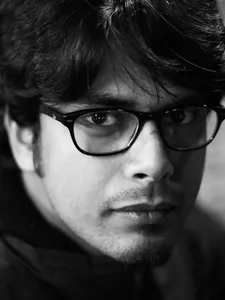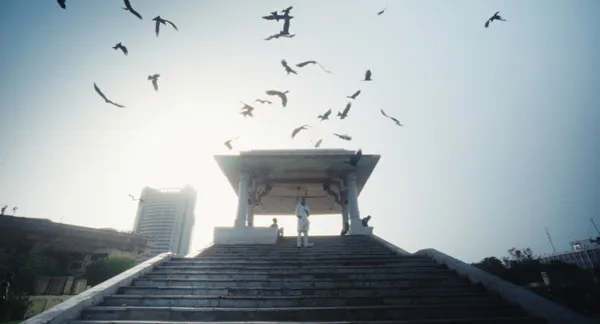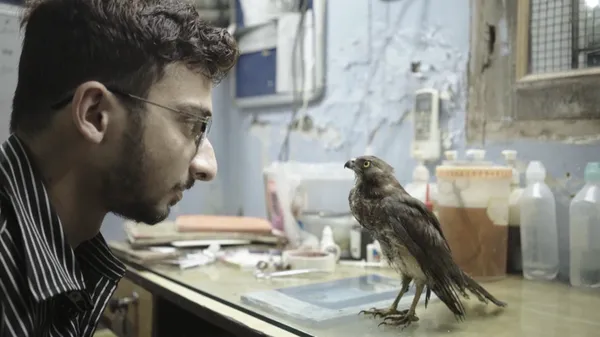Shaunak Sen's documentary All That Breathes takes flight from a small building in Delhi, where brothers Nadeem and Saud treat the injured black kites, to consider the way that humans and animals co-exist and the impact one has upon the other. The result is part nature-documentary, part existential rumination on the nature of living in a city like Delhi, that celebrates stoicism, while also making us consider all the negative things that make the need for that stoicism necessary in the first place.
I caught up with Shaunak over Zoom after his film's premiere at Sundance Film Festival to talk about its themes and how it changed his shooting style.
Can you tell me a bit about how you first came across the story. And, did you already have an eye on the more environmental elements of the film as well as the brothers?
Shaunak Sen: I actually didn't know the brothers at first, when I decided to make the film, in the most vague, abstract sense. Growing up in Delhi, you're sort of always aware the skies are constantly this grey, hazy monotone, which dominates the entire city, you're constantly made aware of the very noxious fumes that you're breathing in. Every house, awfully, has air purifiers, and so on. So you're consciously aware of the sense of the air conditioner of planet Earth going bad, and something's going foundationally wrong, in the most profound sense of the word.
 |
| Shaunak Sen: 'I personally feel enriched by the perspective of the brothers themselves' Photo: Salim Khan |
So, now growing up in the city, with the grey skies and these lazy, gliding dots in the sky, that are the black kites, they were the archetypal picture of this dystopic postcard around you. And I knew in the vaguest sense that I was interested in doing something about the atmosphere, in every sense of the word, these birds that you would keep seeing and growing in numbers, and something to do with the relationship between the human and the nonhuman, especially the bird.
The first sort of guiding principle that I had, when the film was sort of an ineffable glow at the back of my mind - because that's what it initially is - is that I wanted people to step out to the theatres and look up immediately, like the idea was to somehow enchant the sky and enchant the birds.
After doing some research, and having this kind of vague sense of the film, I chanced upon the work of the brothers. And once I met them, I realised there was something singular in this because you go there and you see that it's a tiny derelict basement with these big industrial metal cutting machines. And alongside that there are these birds that are both vulnerable yet magisterial and otherworldly, which are being treated. So this kind of absurd bipolarity of that space immediately draws you in and it's cinematic. So the brothers and their lives, I realised over time, were the perfect kind of emotional anchor or nerve centre of the film. It gave me sort of springboard to them to have this kind of zoomed out broader perspective of nonhuman life in the city itself. So all the shots that you see about life writ large, on the canvas of the city, are made possible because you're very grounded in the specific everyday details of the brother's life. And they form the sort of emotional core. The film initially began as this idea of shuttling between a kind of claustrophobic basement and this broader sweep of the city itself. And this kind of mode of vacillating between extreme compression and decompression was something that informed everything.
It's interesting that you say you're encouraging people to kind of look up to the sky, and yet you start completely on the ground with the rats. That’s quite an juxtaposition. There are many other nature shots through the film, how did you go about scouting them and deciding which to use?
SS: Well, there’s two levels of choosing here. The first thing is that, alongside the story of the brothers we wanted to have this kind of more zoomed out feel and hopefully something that makes people contemplate the more transcendental register of thinking about the city and the different states of life that are involved in it. So we wanted to do something which, in the crew, we short-handed for ourselves as ‘life writ large’. In that, my main interest was in somehow cinematically communicating the simultaneity of life, or the coexistence of things. So, like, if you have a turtle climbing up a heap of garbage, and looking at traffic going by, it sort of immediately puts into perspective different kinds of input. It articulates a kind of simultaneity or copresence of living that most other forms, say writing or description in itself don't communicate. Cinema has some special sway in showing the clashes of different kinds of temporal experience. So that so we were interested in this kind of duration of revealing something – which is why we used a lot of pans.
Yes, you also use pans in the place the brothers are living, emphasising the soap dispensers being made in one area while, very close by, this kind of surgery is occurring.
 |
| Shaunak Sen: 'I wanted people to step out to the theatres and look up immediately, like the idea was to somehow enchant the sky and enchant the birds' Photo: Kiterabbit Films |
How willing were the brothers to be captured on camera? Did you work with them for a very long time?
SS: The first leg of any nonfiction film is less to do with the visual object of the film itself, but the labour one puts in, in terms of earning trust, and getting people used to you and that is an incredibly important part of the process. The first few months are largely about becoming wallpaper in the lives of the characters and also reaching a point where they're bored of you. Once you get the first yawn on camera is when you realise, ah, now they're bored enough and the camera is not an obtrusive presence that they're fascinated by. And it's been the sort of transition from them acting or behaving, to being, on camera occurs. And that's the bit when the richest material comes, where, you know, they're bored of you, you're shooting long hours, and you sort of recede into a background that they don't care about. So that's where in this film it is trickier. My last film, which was a more raw, gritty, every day, observational documentary, where you just turn up and shoot life itself. This was more curated, controlled, with set pieces and so we had to sort of strike a balance between what were the choreographed, stylised, lyrical sections that had to do with the past and that used voiceovers and so on.
We had some happy coincidences, where you find accidents on camera, it's great and infuses life into it. So Salik’s glasses being taken away, for instance, or the presence of kids and birds, both of whom are stupendously indifferent to your designs and your intentions really helps. You can come with whatever intentions on a day’s shoot, but a kite will do something that will disrupt you and that sort of breathes in life to it. The main thing that we had to work hard on in the edit with our editors, Charlotte Munch Bengtsen and Vedant Joshi, was that finding the sweet spot between things that are clearly designed and orchestrated in set pieces as lyrical sections in the middle.
Like the philosophy of the kite, for example?
SS: Exactly and alongside that have enough of life as it unfolded as well. Enough of an immersive ethnographic thing, where you feel like you spent days with the brothers. So the main challenge is to strike a balance between these two things.
You don't like really go into why the kites are falling out of the sky but I got the impression that it's not just the pollution but that also human kite flying is sometimes causing that. Is that right?
SS: Absolutely. The film doesn't point fingers directly but there's a whole panoply of reasons. One is, of course, the fact that the air itself has become more opaque. The brothers often get a lot of cases where birds are literally colliding into buildings running into things. A huge reason, of course, is people kite flying, which is connected also with the air being more opaque generally. The brothers have never spelled out very clearly what the specific scientific reasons could be. They have some hunches, but, I mean, they're not practitioners of science information but there are a lot of cuts and collisions.
Did the level of civic unrest we see developing through the course of the film come as a surprise to you? Or was that something that you suspected was going to happen, given the political situation at the moment.
SS: It definitely wasn't a big surprise. I mean, you'd have to be very insulated as a political subject to feel that you've been caught unawares by it. One, of course, couldn't have anticipated how dramatically the graph increased. But the main thing again, here, was about language. And I was interested in training my gaze firmly on the brothers themselves, and the outside world, replete with its volatilities, and turbulences would leak in, that was a form I was interested in, where nothing is frontally, encountered, but encountered organically through the brothers’ life itself.
Although the themes of the film are quite broad and all encompassing, in the end, your focus, I felt, was laser like. You stay on that street where they're living, we really feel that locale very strongly. And I assume you wanted to root it within this very specific place where they were living rather than wider Delhi, which is an enormous city, obviously.
SS: Yeah, I was absolutely certain about the things that I didn't want to do. And whatever remained became the sum of the film. So I was absolutely certain that we didn't want to make a conventional nature doc or a conventional wildlife doc, I was absolutely certain that I didn't want to make searing political snapshot of the country - that's a different kind of ambition and aspiration, which for this project I definitely did not have. what remained was the core of what the brothers wanted to do. And this sense of nonhuman life writ large on the canvas of the city. And those are the two main things and then there were these other things that helped in creating a denser tapestry of life. That's how life usually goes, right? Our lives are affected by these different resonances and currents that keep affecting us in different smaller, intangible ways. The idea was to try to keep it in that kind of scale and not blow up the scale of some particular current because I personally was more moved ahead. It is about respecting the material that you encountered every day for three years.
Do you feel doing a project like this affects you as a filmmaker going forward?
SS: Of course, because your own film language changes. If you're able to stick true to the kind of mode of expressivity that the characters’ lives in the world that you're trying to represent. If you stick true to forming a language around it, you discover a language yourself, right? So the film's language about slow, languid pans was something that I didn't come armed with, it sort of emanated through the course of three years while doing the film. It's like learning a new language. I think me and the cinematographers, Ben Bernhardt and Riju Das, we sort of picked up this vocabulary as we went along. Secondly, I personally feel enriched by the perspective of the brothers themselves. Unlike a lot of discourse on climate change or the Anthropocene and so on, they’re not governed by this bleeding heart, romanticism of it. There's a kind of wry almost too unsentimental sense of soldiering on that you put your head down and go on, even though you have the front row seats of the Apocalypse, where birds are literally falling off the sky, you sort of do what has to be done. There's a kind of dry humour to them. And that perspective in life, I felt enriched by. It's not a position that I immediately occupy but, you know, when you come in close touch with it for this long, you realise that there are things bigger than you and you have to get on with it. Without the confetti and pomp and show around it.
What do the brothers think of the film?
SS: At first, they were bemused. Because if you shoot for two-and-a-half, three years, we're talking about 150 hours of footage or more. And when that gets whittled down to 87 minutes, the sheer compression of volume almost feels like epistemologically jolting. Also, they didn't at first have a sense of all the nonhuman life shooting that we were doing. So they were like, ‘What is this?’ And, over time, they sense this kind of narrative art building of the relationship between themselves and the kind of emotional dissonance occurring between them. With them, you were never going to get a big reaction. They were happy but they are the epitome of stoic behaviour. They really liked it, but I'd be loath to expect hyperbolic praise.























